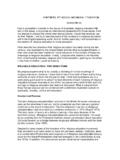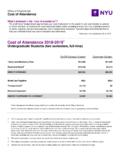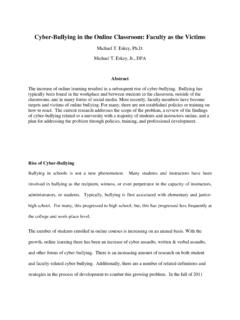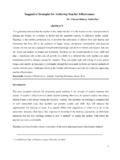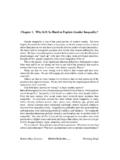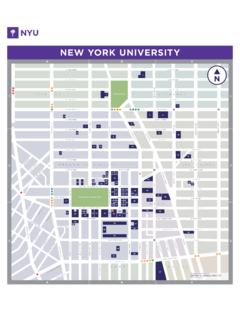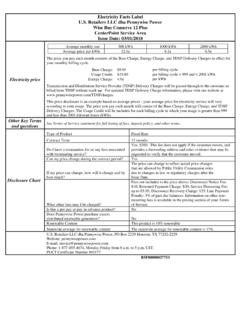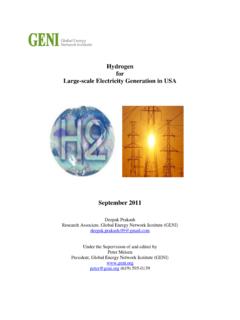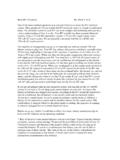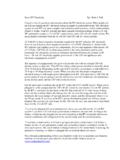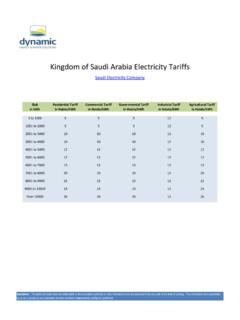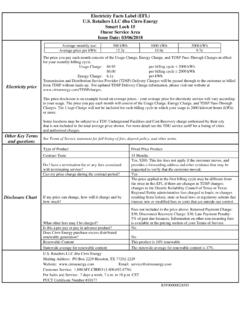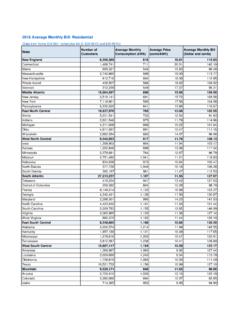Transcription of GENERAL PURPOSE TECHNOLOGIES - nyu.edu
1 Chapter 18 GENERAL PURPOSE TECHNOLOGIESBOYAN JOVANOVICNew York UniversityandNBERPETER L. ROUSSEAUV anderbilt UniversityandNBERC ontentsAbstract1182 Keywords11831. What is a GPT? Summary of Similarities between the Electrification and IT Differences between the Electrification and IT eras11862. Measuring the three characteristics of a Pervasiveness of the Pervasiveness in the Pervasiveness among Adoption by On dating the endpoints of a GPT Improvement of the Ability of the GPT to spawn Investment by new firms vs. investment by incumbents12003. Other symptoms of a Productivity The skill Entry, exit, and mergers should Stock prices should fall1207 Handbook of Economic Growth, Volume 1B. Edited by Philippe Aghion and Steven N. Durlauf 2005 Elsevier All rights reservedDOI: (05)01018-X1182B. Jovanovic and Young firms should do The age of the The age of firms at their The stock market performance of the young vs.
2 Old after Consumption, interest rates, and the trade The trade The consumption income Interest rates12204. Conclusion1221 Acknowledgements1221 References1221 AbstractA GENERAL PURPOSE technology or GPT is a term coined to describe a new method ofproducing and inventing that is important enough to have a protracted aggregate and information technology (IT) probably are the two most important GPTsso far. We analyze how the economy reacted to them. We date the Electrification erafrom 1894 until 1930, and the IT era from 1971 until the present. While we documentsome differences between the two TECHNOLOGIES , we follow David [In:Technology andProductivity: The Challenge for Economic Policy(1991) 315 347] and emphasize theirsimilarities. Our main findings are:1. Productivity growth in the two GPT eras tended to be lower than it was in otherperiods, with productivity slowdowns taking place at the start of the two eras andthe IT era slowdown stronger than that seen during Both GPTs were widely adopted, but electricity s adoption was faster and moreuniform over Both improved as they were adopted, but measured by its relative price decline,IT has shown a much faster improvement than electricity Both have spawned innovation, but here, too, IT dominates electricity in terms ofthe number of patents and trademarks Both were accompanied by a rise in creative destruction and turbulence as mea-sured by the entry and exit of firms, by mergers and takeovers, and by changingvaluations on the stock sum, Electrification spread faster than IT has been spreading, and it did so moreevenly and broadly over sectors.
3 Also, IT comprises a smaller fraction of the physicalcapital stock than electrified machinery did at its corresponding stage. On the otherhand, IT seems to be technologically more dynamic; the ongoing spread of IT and itscontinuing precipitous price decline are reasons for optimism about productivity growthin the 21st 18: GENERAL PURPOSE Technologies1183 Keywordselectricity, information technology, IT revolution, productivity slowdowns, technologyimprovement, creative destructionJEL classification:O3,N21184B. Jovanovic and Rousseau1. IntroductionThe term GENERAL - PURPOSE technology , or GPT, has seen extensive use in recent treat-ments of the role of technology in economic growth, and is usually reserved for changesthat transform both household life and the ways in which firms conduct business. Steam, electricity , internal combustion, and information technology (IT) are often classified asGPTs for this reason. They affected the whole (1991)has pointed out, however, a GPT does not deliver productivity gainsimmediately upon 1shows the evolution of the growth in output per man-hour in the economy over the past 130 years, with periods of rapid diffusion of thetwo major GPTs shaded and the dashed line representing long-term trends as generatedwith the Hodrick Prescott (HP) growth was apparently quite rapidduring the heyday of steam power (c.)
4 1870), but fell as Electrification arrived in the1890s, with the defining moment in the transition probably being the startup of the firsthydro-electric facility at Niagara Falls in 1894. It was only in the period after 1915,which saw the diffusion of machines operated by stand-alone secondary motors and thewidespread establishment of centralized power grids, that electricity finally pervadedbusinesses and households more generally and measures of productivity began to 1also shows that the arrival of IT, which we date with Intel s invention in 1971of the 4004 microprocessor (the key component of the personal computer or PC ),did not reverse the decline in productivity growth that had begun more than a decadeearlier. It seems only now that we are finally seeing computers show up in the produc-tivity it is not obvious that the startup of the Niagara Falls dam and the inventionof the 4004 chip should define the birth of the two GPTs.
5 After all, Thomas Edisoninvented the incandescent bulb in 1879 and by 1882 the world s first large central powerstation had been installed at Pearl Street in New York City, twelve years before we markElectricity s arrival . And large mainframe computers predicted the winner of the Presidential election, nearly two decades prior to the advent of the objective measure is needed, though, and we shall define the start of a GPT era asthe point in time when the GPT achieves a one-percent diffusion in the median is another way to arrive at 1894 and 1971 as the starting points where the shadingbegins inFigure 1. Similarly, we would say that the era is over when the diffusion curveflattens out. For Electrification, it takes until about 1929 for net adoption to reach aplateau, whereas new adoption of IT is still rising today so that, on that criterion, the ITepoch shaded area inFigure 1contains a productivity-growth slowdown in its initialphases.
6 Will the growth slowdown of the current IT era be followed by a rise in growth1 Output per man-hour in the business, non-farm sector is from John Kendrick s series as published of the Census (1975, Series D684, p. 162)for 1889 1947 and from the Bureau of Labor Statisticsfor 1948 2003. For 1874 1889, we use Kendrick s decadal averages for 1869 1879 and 1879 1889 andinterpolate between these benchmarks assuming a constant growth rate from 1874 1884 and 1885 18: GENERAL PURPOSE Technologies1185 Figure 1. Annual growth in output per man-hour, 1874 the first half of the 21st century? If the second shaded area inFigure 1is in somefundamental respects like the first shaded area, then we can expect growth to pick upover the next several decades. InJovanovic and Rousseau (2002a)we have argued thatthe first half of the 21st century will have higher growth than, say, the 1950s and (2000), on the other hand, is pessimistic, arguing that IT does not measure upto electricity and that it will not have such positive results.
7 This chapter, while docu-menting key differences between the diffusion paths of the two TECHNOLOGIES , will in theend conclude that the two GPT eras are strikingly similar in a number of respects. Ifanything, our finding that IT is the more revolutionary of the two GPTs suggests thatits full impact is yet to be chapter is organized around the presentation of a collection of facts. The facts aredescribed mainly through graphs and tables which provide evidence on a set of modelsthat we shall mention as we go along. A primarily analytic survey isGreenwood andJovanovic (2001). What is a GPT?So, what are these fundamental features of GPTs that would allow us to compare oneto another? And more generally, what criteria can one use to distinguish a GPT fromother TECHNOLOGIES ?Bresnahan and Trajtenberg (1996)argue that a GPT should havethe following three The GPT should spread to most The GPT should get better over time and, hence, should keep low-ering the costs of its spawning The GPT should make it easier to invent and produce newproducts or Jovanovic and RousseauMost TECHNOLOGIES possess each of these characteristics to some degree, and thus aGPT cannot differ qualitatively from these other TECHNOLOGIES .
8 Note, too, that the thirdproperty is, in a sense, a version of the first property if we phrase the latter to say thatthe GPT should also spread to the innovation sector. Moreover, this list can be expandedto include more subtle features of GPTs, a subject that we consider in these three basic characteristics to be a useful starting point for evaluating and com-paring the impact of various TECHNOLOGIES through history. Investigating how Electricityand IT measure up on these three dimensions is the focus of Section2. But first, wesummarize our overall Summary of findingsThe evidence shows similarities and differences between the Electrification and the ITeras. Electrification was more pervasive (#1), whereas IT has a clear lead in terms of im-provement (#2) and innovation spawning (#3). Let us list the similarities and differencesin more Similarities between the Electrification and IT eras1. In both eras productivity growth rates are below those attained in the decadesimmediately preceding the GPT s Measures of reallocation and invention the entry and exit of firms to the stockmarket, investment by new firms relative to incumbents, and grants of patents andtrademarks are all higher during the GPT Private consumption rises gradually during each GPT Real interest rates are about the same during the two GPT eras, and about threepercentage points higher than from 1930 to 1970 the period between the rapidadoptions of electricity and Differences between the Electrification and IT eras1.
9 Innovation measures are growing much faster for IT than for Electrification patents and trademarks surge much more strongly during the IT era, and the priceof IT is falling 100 times faster, at least, than did the price of IT is spreading more slowly than did Electrification, and it comprises a smallerpart of the capital stock. Its net adoption continues to rise in the United The productivity slowdown is stronger in the IT No comparable sudden collapse of the stock market occurred early on in the Elec-trification The Electrification era saw a surplus in the trade balance, in part becauseEurope had to finance a string of wars, whereas the IT era finds the United Stateswith consistent trade 18: GENERAL PURPOSE Technologies1187 The differences seem to be quite important. But overall the evidence clearly supportsthe view that technological progress is uneven, that it does entail the episodic arrival ofGPTs, and that these GPTs bring on turbulence and lower growth early on and highergrowth and prosperity later.
10 The bottom line is that with a wider body of data and fifteenmore years of it thanDavid (1991)had at his disposal, we confirm his hypothesis thatElectrification and IT adoption are manifestations of the same force at work, namely theintroduction of a Measuring the three characteristics of a GPTAs suggested inFigure 1, we shall choose electricity and IT as our candidate GPTs, andthe measures that we construct will pertain mostly to these two TECHNOLOGIES . In passing,we shall also touch upon steam and internal combustion. The three subsections belowreport, in turn, various measures of each characteristic pervasiveness, improvement,and innovation for the two GPTs at Pervasiveness of the GPTThe first characteristic is the technology s pervasiveness. We begin by looking at aggre-gates and proceed to consider individual industrial sectors in more Pervasiveness in the aggregateIdeally we would like to track the evolution of various candidate GPTs using continu-ous time series from about 1850 to the present, but we do not have data that consistentlycover this entire stretch of time, and thus will need to work with two overlapping seg-ments: 1869 1954 and 1947 2shows the shares of total horsepower in manufacturing by power source from1869 to period covers the decline in usage of water wheels and turbines,the rise and fall of steam engines and turbines, the rise and gradual flattening out ofthe internal combustion engine s use in industrial applications, and the sharp rise in theuse of primary and secondary electric motors.
